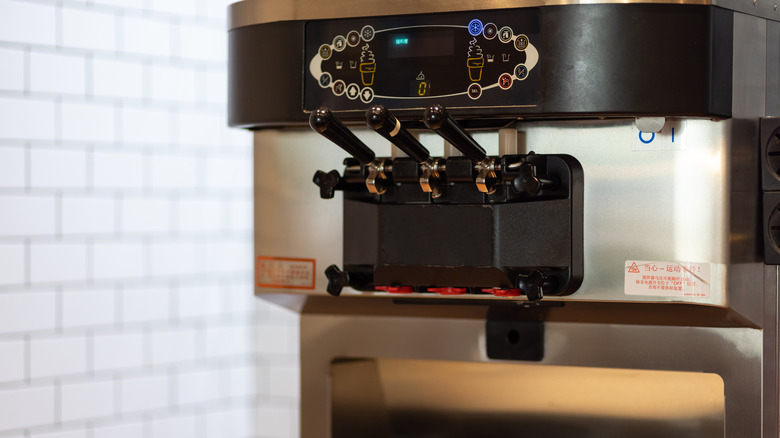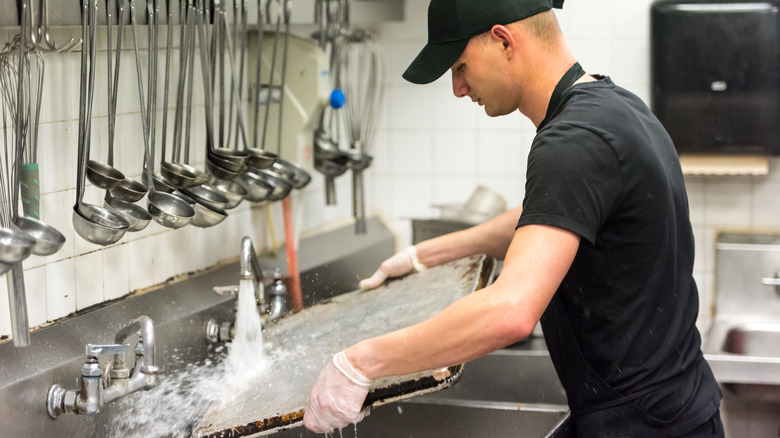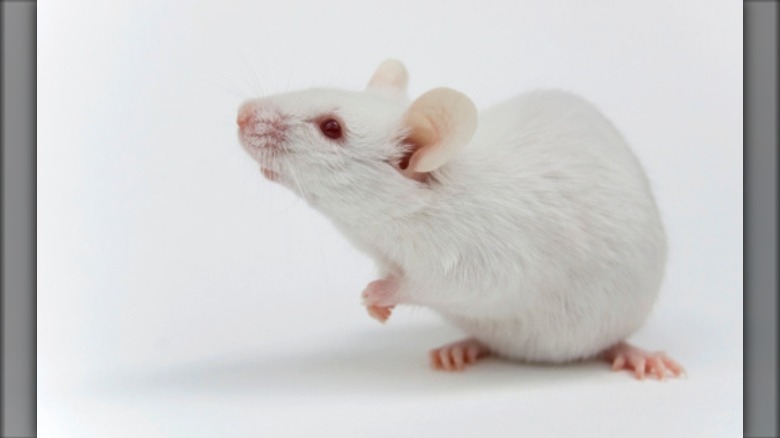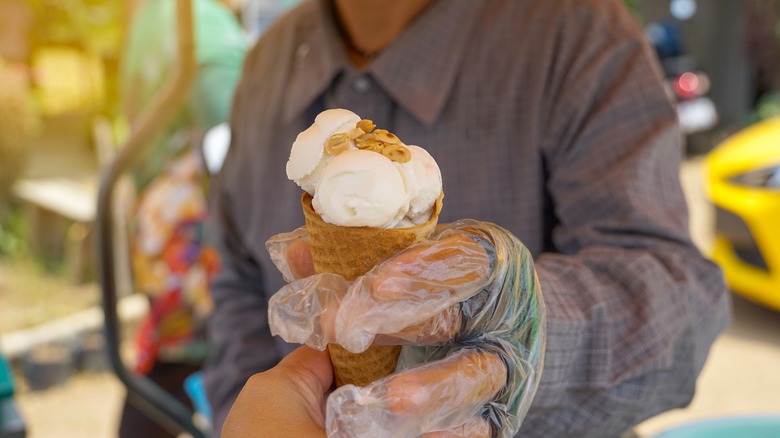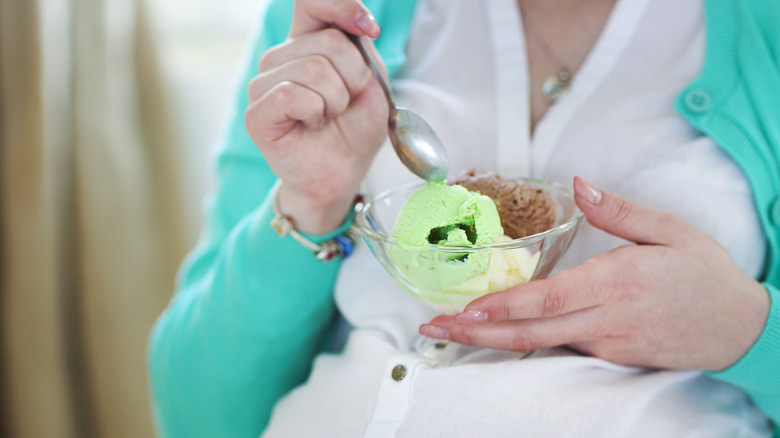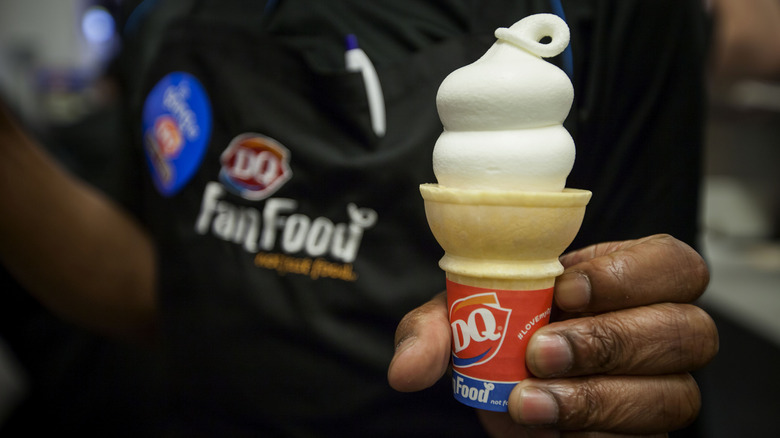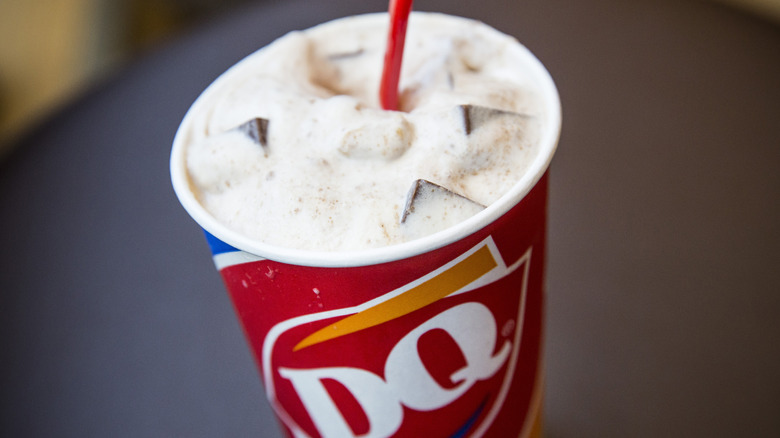Why You Should Think Twice Before You Order Fast Food Ice Cream
What's better on a hot summer day than swinging through your favorite fast food joint and ordering a delicious soft-serve ice cream? Whether you prefer vanilla in a classic cone, a milkshake, or a candy-infused mixture, á la a Blizzard or McFlurry, that soft serve just hits differently compared to what you'd be able to pick up at the grocery store. Better yet, even if local ice cream shops are shuttered for the season, you can still rely on fast food restaurants to keep on churning out soft serve regardless of the weather. If you want to order that Blizzard in the middle of a literal blizzard, you can do so.
However, for all the awesome, tasty qualities that fast food ice cream delivers, there are, unfortunately, a few reasons why you might want to think twice before you place your order — and, yes, those reasons go beyond just the annoyance of the ice cream machine being supposedly "broken" yet again. Here's everything you might want to consider before you indulge in a sweet frosty treat.
The ice cream machine may not be that clean
If you've ever worked in a fast food restaurant before, you know that, even though there are strict cleaning protocols and measures that employees are meant to follow, there are still some not-so-secret spots where grime, old frying oil, dirt, and other nasty substances are likely to lurk. According to one Redditor, one of those spots could be in and on the restaurant's ice cream machine. The Redditor said they were once a supervisor at a fast food restaurant, and they still can't eat fast food ice cream due to their experience. They reported that their restaurant's ice cream machine was more likely than not to be "covered in mold and spoiled cream," and the best the owners would do to remedy the situation? "Scrape off a layer of mold and spray some Clorox on it," they said.
Of course, other Reddit users jumped in with their own, wildly different experiences, noting that, during the days of their fast food employment, management could be incredibly strict regarding cleanliness, including when it came to the ice cream machine. Still, it's worth thinking — is your favorite fast food stop one of the clean or not-so-clean ones?
Cleaning schedules can be erratic
Some fast food restaurants might clean their ice cream machines regularly. Some may not clean their ice cream machines at all. Some might just clean their ice cream machines every once in a while. This type of erratic schedule can spell danger to your health.
Why the erraticism? Sometimes, cleaning an ice cream machine can just be too much work and take too long. According to one Reddit thread and a group of prior and (at the time) current McDonald's employees, the cleaning schedule for the McDonald's ice cream machines can differ according to location. Some might clean their machines daily, but since the process can take multiple hours, some may only clean their machines once per week. Still, others reported only thoroughly cleaning their machines every other week. One way to know how often your McDonald's is cleaning its machines? The more often you swing by and order an ice cream, only to be told the machine is broken, the more often the machine is likely being cleaned; when a McDonald's employee tells you that the machine is broken, that, according to employees, is code for cleaning.
Some ice cream machines might house insects
We know that, in most cases, eating an insect or two isn't going to harm you. In fact, in some cases, eating the right insects can be pretty beneficial, since insects provide a calorie-dense, nutritious source of complete proteins and are far more environmentally friendly than other protein sources like beef. Even if you're not actively trying to eat some creepy-crawlies, though, chances are good that you likely are, as the U.S. Food and Drug Administration allows a certain amount of insect bits that unavoidably making their way into common food products such as chocolate, tomato products like pizza sauce, and pasta before it will take action.
All that said ... just because eating insects is beneficial to your health and you probably are eating a few, unknowingly, throughout your daily life, many folks would not willingly chow down on a cricket or a housefly. However, according to one prior Sonic employee who took to Reddit, that's exactly what you might be doing when you order fast food ice cream. The employee reported that, at the end of the summer, when they finally, for the first time that season, cleaned out one particular part of their ice cream machine, they found not just mold, but also a friendly little fly.
Some ice cream machines might host a resident rodent
Yes, the FDA does allow for a small amount of rodent hairs to make their way into food products. In fact, the federal agency even says that it is "economically impractical" to attempt to produce food without encountering contaminants like rodent hair. The good news? Supposedly Mickey's fur is "non-hazardous." The bad news? It's still gross.
What's even grosser than finding a few rat hairs in your chocolate bar, though, is finding a decimated mouse in your ice cream machine. According to one Reddit poster who worked at McDonald's, another location once called to ask about problems with their ice cream machine. The eventually uncovered problem? A mouse had found its way inside and was eventually processed by the ice cream machine's mixer. While other Redditors came to the restaurant's defense by referencing the FDA's allowance of rodent hairs in certain foods, we can all probably agree: There's a big difference between a few stray hairs and a whole, processed mouse.
Even if the machine is clean, what goes into the ice cream might not be
Many favorite fast food ice cream treats blend soft serve with an array of mix-ins and toppings, from fruit to cheesecake chunks, crushed candy to sprinkles and sauces. While these mix-ins are definitely tasty, though, they just further increase the likelihood that you could be consuming unsanitary ingredients. Even if the ice cream machine is totally clean and produced totally safe ice cream, if those mix-ins weren't stored or handled correctly, they could ruin the whole thing.
According to one Reddit user who commented on their experience working at Sonic, it was not at all uncommon for employees to use their bare hands to scoop out the candy that would be used in the chain's milkshakes. This was, supposedly, especially the case during busy periods, when the candy station needed to be refilled from bulk bags, and there just wasn't enough time to follow proper procedure; thus, employees would dig into the candy with their bare hands, grabbing a whole fistful of chocolate or other ingredients.
Some ice cream machines might contain dangerous allergens
Let's say that a fast food restaurant religiously cleans its ice cream machine. There's no mold, insects, mice, or other nasty substances in sight. It looks perfectly pristine and safe for every diner who comes in craving a soft-serve cone or sundae. However, that still might not actually be the case.
While some ice cream machines may be clean, they might still harbor allergens that, if the right person were to consume them, could cause extreme illness or even death. For example, one Reddit user reported that, when working at Jack in the Box, the locations used the same machines for both fruit smoothies and soft-serve ice cream — meaning anyone with a fruit allergy who ordered a soft-serve item could be putting themselves at risk. Likewise, someone with a dairy allergy who ordered a fruit smoothie could also get exposed. In other instances, fast food chains may simply carry an allergen that could contaminate other products, as was the case when McDonald's Canada began offering a McFlurry flavor that contained non-packaged nuts, forcing the brand to release a statement in 2017 saying that all products at its restaurants could, as a result, have nuts, according to CBC News.
Contaminated soft serve can make you seriously ill
No matter how a soft serve machine or the ice cream becomes contaminated, the results can be the same: a serious illness.
In the early 2000s, more than a hundred people ate contaminated ice cream at a McDonald's in Ohio, as NBC reported. The ice cream was infused with staphylococcus, which caused so many illnesses so rapidly that it shocked the town's hospital. (Staphylococcus food poisoning comes with a range of gastrointestinal side effects that can start as little as half an hour after eating a contaminated food.) If that's not enough to make you think twice about ordering fast food ice cream, just take it from a food poisoning expert who told Insider that he never orders soft serve at a restaurant due to the risk of fatal listeria poisoning. And, unfortunately, even if you think you're safe from listeria poisoning if you avoid restaurant soft serve, you might find the bacteria in your store-bought ice cream, too. In 2015, there was a multi-state outbreak of listeria linked to certain Blue Bell Creameries products.
Pregnant women are particularly at risk
While listeria is the third-most likely cause of death via a food poisoning incident – killing more than 200 people in the United States every year, according to the CDC – most healthy individuals are not at risk of dying. That said, there are populations that are more likely to become severely ill than others, including pregnant women. Because of this, some experts recommend not eating any soft-serve ice cream or products made from soft-serve ice cream, like milkshakes, during pregnancy.
While ice cream made from pasteurized milk won't contain listeria on its own, the threat comes from the ice cream machine itself, which is more likely to harbor listeria and then transfer that bacteria into the ice cream. Once in the ice cream, the listeria can give you either food poisoning or a listeriosis infection that could cause miscarriage or stillbirth. If you absolutely must order soft serve, try your best to order only from a restaurant that you know is regularly and thoroughly cleaning its ice cream machine or regularly pasteurizing its machine, a process that heats the machine to levels hot enough to kill listeria.
Fast food ice cream can contain a lot of extra sweeteners, preservatives, and carrageenan
Beyond the contamination worries that come with ordering fast food ice cream, there's also just the fact that fast food ice cream often contains a lot of different ingredients that you might not normally find — or want — in store-bought or homemade ice cream. For example, a Dairy Queen chocolate shake includes ingredients such as artificial flavors, high fructose corn syrup, and carrageenan. Likewise, a Wendy's Frosty contains sunflower creamer, stabilizers, and more of that carrageenan.
You may be familiar with the high fructose corn syrup and artificial flavorings, but what exactly is carrageenan? A seaweed derivative found in processed dairy, carrageenan thickens creamers, ice creams, and the like. However, while it is a FDA-approved ingredient, it's still a little suspect, with some sources, including this report from a nonprofit consumer education and watchdog group called The Cornucopia Institute, finding carrageenan can cause intestinal tumors, glucose intolerance, inflammation, and other nasty side effects. While the research isn't substantial enough for brands to limit their use of the stuff, it still might not be something you want to consume on a regular basis.
Cardiologists say fast food ice cream is one of the worst fast foods for your heart health
It's no secret that foods filled with sugar and fat aren't exactly great for your health. However, you probably think that you could do worse at a fast food restaurant than ordering a soft-serve cone, right? The french fries and burgers are definitely worse for your health?
Well, maybe not. According to a cardiologist who spoke to Yahoo Life, fast food ice cream is an indulgence you'll want to avoid at all costs if you're attempting to protect your heart health. These decadent desserts can be even more dangerous following a fast food meal, which likely already increased your blood sugar levels. The ice cream, especially when covered in sweet sauces and candy, he noted, can sometimes contain as much sugar as eight doughnuts or as many calories as two of those fast food sandwiches that you already ate. As further proof, a look at the McDonald's menu shows that an M&M McFlurry contains 640 calories — more than the 590 calories you get from a Big Mac.
Processed foods like fast food ice cream can hurt your brain health
Not worried about your caloric intake, your sugar consumption, or your heart health? What about your brain health? As reported by USA Today, research presented at the Alzheimer's Association International Conference in 2022 found that the more highly processed foods you eat, the more your brain function will likely decline. Experts further detailed how even just a hundred calories of processed food can cause a negative impact, inflaming your brain.
Some of the foods that were listed as potentially too-processed for your brain health included store-bought bread and other bakery items, soda, hot dogs, frozen meals, cream cheese, and, yes, ice cream — and not just fast food ice cream, but all ice cream (though ice cream wasn't listed as the worst offender; that honor went to restaurant fried foods). Unfortunately, though, if you eat a lot of these items, you aren't alone. Other research found that nearly 60% of the calories Americans consume each day come from ultra-processed foods like these.
Some fast food ice creams pack in more fat and sugar than what's recommended for an entire day
Expert research and recommendations aside, if you're just following the government guidelines for the amount of fat and sugar you should consume each day, you still may struggle to find fast food ice cream options that fit within these limits. If you're following a 2,000-calorie-a-day diet, it's recommended that you eat between 44 grams and 78 grams of fat per day. Likewise, a 2,000-calorie-a-day diet should not include more than 50 grams of added sugar.
Meanwhile, a large Wendy's Chocolate Frosty contains 66 grams of sugar. An M&M McFlurry at McDonald's contains 69 grams of added sugar (83 total grams of sugar). A Chick-fil-A chocolate or strawberry milkshake contains 87 total grams of sugar. A Sonic large M&M Blast and Reese's Peanut Butter Cups Blast both contain 80 grams of fat (not to mention the 100-plus grams of sugar for each one). Of course, you can love all things in moderation, so these treats and other high-fat, high-sugar fast food ice creams like them can be enjoyed every once in a while as part of a balanced diet — but maybe try to avoid eating them regularly or if you're trying to watch your fat or sugar intake for health reasons.
Depending on what you order, you might be getting ripped off
If health concerns won't convince you to think twice about your fast food ice cream order, maybe losing money will be enough of a concern to make you hesitate. In some instances, your fast food ice cream could be leaving you with less than what you thought you paid for.
According to a Redditor who said they worked at Dairy Queen, when you order a large Blizzard, you're not really getting a full cup of the soft serve with sugary pieces of candy or other treats mixed throughout. Instead (and you may have noticed this before), the bottom few inches of the large cup is filled with plain soft serve. Dairy Queen isn't doing this to intentionally rip you off; instead, the Redditor explained, Dairy Queen's blender that mixes its Blizzards can't actually handle the large cups. The spindle only reaches so far down into the cup, so it only mixes the top portion of the soft serve with the candy or other mix-ins. You're better off going with a medium-sized Blizzard if you want your money's worth.
You can make your own soft serve at home in 5 minutes with three ingredients
Does all the above turn you off to fast food ice cream? You don't have to give up your beloved soft serve for good. Instead, just switch things up and go the homemade route instead. You can make your own soft serve at home with just five minutes and three ingredients. With some frozen fruit, dairy, sugar, and an immersion blender, you're just a few seconds away from a tempting sweet treat.
Of course, if a little culinary creativity is your preference, you can always use one of several ice cream hacks to liven up your dessert options at home. Try making dairy-free ice cream from bananas, making ice cream with just some storage bags and ice, making ice cream with whipped cream, or changing up the way you package your favorite ice cream by ditching the cone and, instead, frying the ice cream in your air fryer or serving it up between two slices of bread (yes, really!).

